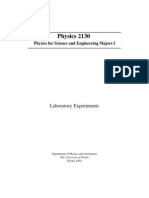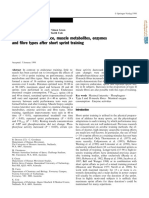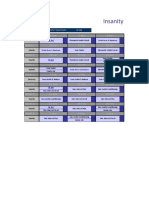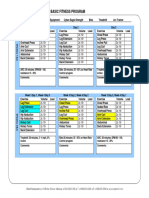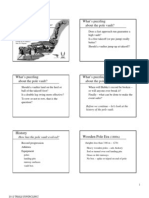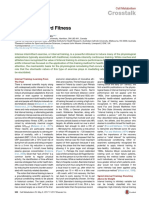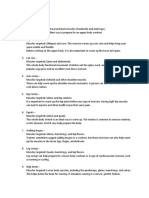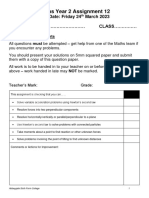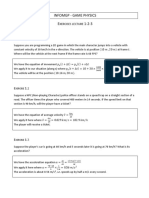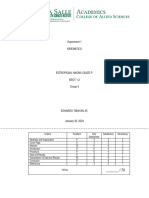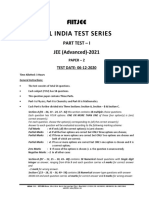Rahman Et Al 2001 - Force-Velocity and Power Velocity Relationships in Squat Exercise
Rahman Et Al 2001 - Force-Velocity and Power Velocity Relationships in Squat Exercise
Uploaded by
willipilliCopyright:
Available Formats
Rahman Et Al 2001 - Force-Velocity and Power Velocity Relationships in Squat Exercise
Rahman Et Al 2001 - Force-Velocity and Power Velocity Relationships in Squat Exercise
Uploaded by
willipilliOriginal Title
Copyright
Available Formats
Share this document
Did you find this document useful?
Is this content inappropriate?
Copyright:
Available Formats
Rahman Et Al 2001 - Force-Velocity and Power Velocity Relationships in Squat Exercise
Rahman Et Al 2001 - Force-Velocity and Power Velocity Relationships in Squat Exercise
Uploaded by
willipilliCopyright:
Available Formats
Eur J Appl Physiol (2001) 84: 227232
Springer-Verlag 2001
ORIGINAL ARTICLE
Abderrehmane Rahmani Fabrice Viale Georges Dalleau Jean-Rene Lacour
Force/velocity and power/velocity relationships in squat exercise
Accepted: 19 September 2000
Abstract The purpose of this study was to describe the force/velocity and power/velocity relationships obtained during squat exercise. The maximal force (F0) was extrapolated from the force/velocity relationship and compared to the isometric force directly measured with the aid of a force platform placed under the subject's feet. Fifteen international downhill skiers [mean (SD) age 22.4 (2.6) years, height 178 (6.34) cm and body mass 81.3 (7.70) kg] performed maximal dynamic and isometric squat exercises on a guided barbell. The dynamic squats were performed with masses ranging from 60 to 180 kg, which were placed on the shoulders. The force produced during the squat exercise was linearly related to the velocity in each subject (r2 0.830.98, P < 0.050.0001). The extrapolated F0 was 23% higher than the measured isometric force (P < 0.001), and the two measurements were not correlated. This may be attributed to the position of the subject, since the isometric force was obtained at a constant angle (90 of knee exion), whereas the dynamic forces were measured through a range of movements (from 90 to 180). The power/velocity relationship was parabolic in shape for each subject (r2 0.940.99, P < 0.010.0001). However, the curve obtained exhibited only an ascending part. The highest power was produced against the _ lightest load (i.e., 60 kg). The maximal power (Wmax ) and optimal velocity were never reached. The failure to ob-
serve the descending part of the power/velocity curve may be attributed to the upper limitation of the veloci_ ties studied. Nevertheless, the extrapolation of Wmax from the power/velocity equation showed that it would be reached for a load close to body mass, or even under unloaded conditions. Key words Dynamic Isometric Force/velocity relationship Extrapolated isometric force Power/ velocity relationship
Introduction
Squatting with a mass on the shoulders is one of the most widely used training exercises for the development of strength in the lower leg extensor muscles (McLaughlin et al. 1977), or for general tness and rehabilitation exercises (Beynnon and Johnson 1996). In general, the load is set at a percentage of the maximum weight the individual can lift once with proper form and technique (the one-repetition maximum). However, the weight used is not the only parameter that must be considered in strength training. Programs using dierent speeds of movement have shown a velocity-specic increase in strength (Behm and Sale 1993). Training with heavy loads is used to enhance strength, whereas training with light loads improves power production (Caiozzo et al. 1981; Kanehisa and Miyashita 1983; Kaneko et al. 1983). This means that to achieve a specic performance enhancement, athletes must perform training exercises at the specic load and velocity that best correspond to the muscular performance in the competitive movement (Wilson et al. 1993). Therefore, force/velocity and power/velocity relationships are the ideal parameters to study for determining the conditions of muscular work required. The use of force/velocity and power/velocity relationships during isokinetic (Perrine and Edgerton 1978) and ballistic (Rahmani et al. 1999) monoarticular movements, and during pluri-articular cycling
A. Rahmani (&) J.-R. Lacour Laboratoire de Physiologie de l'Exercice GIP Exercice, Faculte de Medecine, Lyon Sud, BP 12, 69921 Oullins Cedex, France e-mail: abdel.rahmani@univ-lyon1.fr Tel.: +33-478863135; Fax: +33-478863135 F. Viale G. Dalleau Centre Universitaire de Recherche en Activites Physiques et Sportives, Faculte des Sciences et Technologies, Universite de la Reunion, 117 rue du General Ailleret, 97430 Le Tampon, France
228
movements (Hautier et al. 1996; Vandewalle et al. 1987) is now well-established. Setting the force and power/ velocity relationships enables the determination of different indicators of muscle function. Some authors have assessed the theoretical maximal isometric force (F0) and the theoretical maximal velocity (v0), which are dened as the intersection of the force/velocity relationship with the force and the velocity axis, respectively, directly from dynamic performance (Driss et al. 1998; Vandewalle et al. 1987). Although the relationship between the dynamic and the isometric performance remains to be resolved (for review, see Wilson and Murphy 1996), no study has been conducted to validate this fact from a force/velocity relationship obtained during squat exercise. It may be useful to be able to predict isometric force directly from the extrapolation of the force/velocity relationship without the use of a force-plate. In addition, the parabolic power/velocity relationship gives a specic _ parameter, the maximal power (Wmax ) obtained at the corresponding optimal velocity (vopt; Hautier et al. 1996). These models were obtained from cycling or mono-articular exercises, which are very dierent from the loading and limb pluri-articular extension conditions observed in a squat movement. Whether these parameters can be assessed with a squatting exercise has yet to be established. The purpose of this study was thus to describe the force/ and power/velocity relationships of a squatting movement by determining the dierent muscular para_ meters (i.e., F0, Wmax and vopt), and by comparing the measured F0 to the extrapolated theoretical F0.
(Bemben et al. 1990). Subjects performed three trials and had 5 min rest between trials. For the dynamic tests, only the concentric part of the squat was considered. The mechanical stops were positioned below the bar at the appropriate angle. Upon an auditory command, the subjects applied force as explosively as possible with an extra load of 60 180 kg (increased in 20-kg increments) on the shoulders. Subjects had to provide the fastest acceleration they could. Therefore, for the lightest loads, the subjects took o from the ground. The barbell was maintained in contact with the shoulders of the subjects throughout the motion. Subjects performed two trials at each load. Each trial was followed by a rest period of at least 3 min. Data collection When performing the various isometric and concentric tests, the subjects stood directly over a Kistler (9281B) force plate. The force plate was mounted according to the manufacturer's specications. Charge ampliers (Kistler type 9861 A, Kistler Instruments) amplied analog signals from the force-plate. The ampliers were reset to zero before the subject stood on the plate. The force signal was linear (<0.05%) over a range force of 0 10 kN. The resonant frequency of the force plate was >200 Hz. Data were sampled at a rate of 1000 Hz for the isometric contractions and 200 Hz for the concentric ones. The sampled frequency during the isometric contractions was overestimated, but this did not inuence the evaluation of F0. This frequency was chosen to determine the isometric rate of force development included in the evaluation protocol requested by the Alpine Skiing Federation. Data were stored on a PC computer (486 DX2, 66 MHz) via electronic interface cards equipped with a 12bit A/D converter card (National Instrument France, type PCLPM16, Le Blanc-Mesnil, France). The signals were ltered digitally with a 12-Hz low-pass Butterworth lter with zero phase lag. Several variables from the vertical force components were calculated from ground reaction force data over the entire sampling period for both the isometric and dynamic curves. The maximal force was identied as the highest values attained during the movement. The instantaneous vertical velocity produced during the dynamic squat was integrated from the acceleration, provided from the force signal, divided by the whole mass, after subtraction of the gravitational acceleration. The integration constant was zero because there was no initial movement. The instantaneous power was the product of the force and velocity at any given point. Data analyses The isometric peak force per body weight (IPF) and the dynamic peak force (DPF), which were determined from the force/time curves, were analyzed. The mean force, the mean velocity and the mean power of the push-o phase were all the average of instantaneous force, velocity and power values, respectively, measured during the period of a complete repetition. The mean of the three trials for the isometric tests and the mean of the two trials for the dynamic trials were considered as the most representative measures of muscle function and were used in further analyses. Bearing in mind that few data points were available, the linear force/velocity model proposed by other authors (e.g., Bosco et al. 1995; Vandewalle et al. 1987) t the measured data best. The use of a non-linear force/velocity model would not consistently increase the r2 values. Therefore, it was logical to use a seconddegree polynomial model to describe the power/velocity curve, since this relationship is derived from the product of the force and the velocity. These curves were extrapolated to obtain F0 and v0 (which correspond to the intercept of the force/velocity curve with _ the force and the velocity axis, respectively), vopt and Wmax (corresponding to the velocity and power at the highest point of the power/velocity curve).
Methods
Subjects Fifteen international alpine skiing racers volunteered and gave their informed consent to take part in the study. All of the subjects were accustomed to developing maximum eort during both isometric and dynamic squat exercises. Their mean (SD) age, height and body mass were 22.4 (2.6) years, 178 (6.3) cm and 81.3 (7.7) kg, respectively. The testing session was part of a standard evaluation procedure that was developed by the French Skiing Federation. Tests Isometric and dynamic tests were conducted on a modied guided horizontal barbell (Multipower Basic, Panatta Sport, Apiro, Italy) that was positioned over a Kistler force plate (Kistler type 9281 B, Kistler Instruments, Winterthur, Switzerland). For the isometric contraction mode, the tests were performed at a knee angle of 90. For the dynamic tests, the subjects performed squat jump exercises from a 90 knee angle to full extension. Quantication of the 90 angle was performed with a goniometer (model SEEB 502, accuracy 1, Sfernice, Nice, France). Once the position was determined, mechanical stops that were xed into the guided barbell were positioned so that the appropriate angle was achieved. For the isometric tests, the mechanical stops were located above and below the bar to securely x it in the appropriate position. Subjects were instructed to perform the contraction as rapidly and forcefully as possible and to maintain it for 5 s. When the aim of testing is to record F0, these instructions produce optimal results
229 Statistical analysis Data are presented as the mean (SD). The level of statistical signicance was set at P < 0.05 for all statistical procedures. In agreement with the statistical norms (Vincent 1995), the trial-totrial reliability was tested by assessing the intraclass correlation coecient (IC) between the three trials performed during the isometric contractions, and between the two trials performed during the dynamic contractions. The IC was calculated from a one-factor repeated-measures analysis of variance. The standard error of the mean (SEM%) was also computed to test the reliability. Pearson product moment correlation coecients (r) were used to determine the signicance of the force/velocity and power/velocity relationships. A paired t-test was used to determine whether there were signicant dierences between the isometric and dynamic parameters. The coecient of variation (CV%) was determined to compare the variability of the dynamic and isometric measurements, and to determine the variability of the slope of the force/velocity relationship.
Results
Reliability The mean values of the peak forces, the trial-to-trial IC and the SEM% for both the isometric and dynamic variables are presented in Table 1. The IC for the isometric contraction was 0.98, and varied from 0.69 to 0.88 for the dynamic contractions. The SEM% was less than 3% for both the isometric and dynamic contractions. Force/velocity relationship The courses of the average forces developed during squat exercises performed with various loads (from 60 to 180 kg) by the whole group (n 15) and, as an example, by a typical subject, as a function of the average velocity of the barbell are shown in Fig. 1. The force/velocity relationship exhibited a signicantly linear shape in the whole group (r2 0.99, P < 0.001; F )13.4 v + 41.2) and for each subject (r2 0.830.98, P < 0.050.0001). The force generated during the dynamic squat increased with the resistance lifted. The mean CV% of the slope was 25.8% (extreme absolute values: 5911495). The mean (SD) F0 and v0 extrapolated from the force/ velocity relationship were 40.9 (3.3) N kg)1 and 3.31 (0.75) m s)1, respectively. The mean (SD) IPF mea_ Table 1 Peak forces [Wpeak , presented as the mean (SD)], intraclass coecient of reliability (IC), standard error of mean (SEM%) and coecient of variation (CV%) of the isometric and dynamic variables Load (kg) Isometric 60 80 100 120 140 160 180 _ Wpeak (Nkg)1) 31.7 32.9 34.6 36.3 37.9 34.5 41.3 43.3 (7.8) (2.5) (2.2) (2.4) (2.5) (2.6) (2.6) (3.3) IC 0.98 0.88 0.69 0.88 0.84 0.84 0.88 0.87 SEM% 2.6 2.0 2.9 2.1 2.2 2.0 1.8 1.7 CV% 24.6 7.5 6.4 6.7 6.7 7.5 6.2 7.7
Fig. 1 Courses of mean forces (in Nkg)1) developed during squat exercises performed with various loads (from 60 to 180 kg) by the whole group (triangles, n 15) and, as an example, by a typical subject (circles), as a function of the average velocity of the barbell (in ms)1). The open symbols represent the measured isometric force. Values of the whole group are presented as their mean and standard deviation
sured from the isometric squat exercise was 31.7 (7.8) Nkg)1. The F0 was 23% higher than IPF (P < 0.001), and the two were not correlated. The peak force was reached at a mean (SD) knee angle of 109.7 (2.7), whatever the load (P < 0.05). The CV% was 24.6% for IPF and 6.9 (0.6)% for the DPF. Power/velocity relationship The courses of the average powers developed during squat exercises performed with various loads (from 60 to 180 kg) by the whole group (n 15) and, as an example, by a typical subject, as a function of the average velocity of
Fig. 2 Courses of the average powers (in Wkg)1) developed during squat exercises performed with various loads (from 60 to 180 kg) by the whole group (triangles, n 15) and, as an example, by a typical subject (circles), as a function of the average velocity of the barbell (in ms)1). Values of the whole group are presented as their mean and standard deviation
230
the barbell are drawn in Fig. 2. The power/velocity relationship was described by a second-order function for each subject (r2 0.940.99, P < 0.010.0001). The power decreased as the load increased. The curve obtained _ exhibited only an ascending part. Wmax and vopt were never _ reached. The mean (SD) extrapolated Wmax and vopt were )1 )1 30.4 (4.5) Wkg and 1.51 (0.41) ms , respectively.
Discussion
Reliability According to the statistical norms (Vincent 1995), the reliability coecients reported in this study were very good for IPF (0.98) and moderate to good for the dynamic contractions (IC 0.690.88 for DPF). These coecients are in line with those described previously for isometric and dynamic contractions. The reliability coecients have been shown to vary from 0.85 to 0.99 during isometric contractions (Bemben et al. 1992; Wilson et al. 1993), from 0.92 to 0.98 in weightlifting contractions (Hennessy and Watson 1994; Hortobagyi et al. 1989), or higher than 0.9 during isokinetic contractions (Taylor et al. 1991). The low SEM% value (<3%) supported the good reliability of the squat exercise as compared with the method error encountered during isokinetic leg-press contractions (from 2.0 to 9.8%, Vandervoort et al. 1984) or isokinetic leg extensions (>5%; Sale 1979). The good reproducibility of both the isometric and dynamic squats shows that the squat exercise is a reliable exercise that can be used to quantify the improvement following strength training from one session to another or during rehabilitation interventions. Force/velocity relationship The squat exercise exhibited a linear relationship between force and velocity in the whole group (P < 0.05). This linear relationship is in agreement with those obtained during cycling exercise, which is another pluriarticular movement (Vandewalle et al. 1987). From a practical point of view, this linear relationship, obtained from squat exercises, makes it possible to evaluate the strength values produced at dierent loads, and the comparison of the results from one session to another at a given load. The slope of the force/velocity relationship exhibits major variability (CV% 25.8%) in this homogeneous group. Whether or not this slope is related to muscle ber composition remains to be elucidated. In addition, the force/velocity relationship can be used to evaluate the resistance-training eect on the movement either by an eect on the maximal strength developed or by an eect on the v0 achieved. The eect of training on the shape of force/velocity curves is related to the training loads and velocities used. This type of strength training results in improvements in all portions of the
force/velocity curve: changes in the high force portion of the curve are essentially due to strength training, while changes in the small force portion are mainly due to power training (for review see Morrissey et al. 1995). Some authors have assessed the F0 of cycling exercise by extrapolating the force/velocity curve up to the force produced at null velocity (i.e., the intersection of the curve with the force axis; Butelli et al. 1996; Vandewalle et al. 1987). Compared to these studies, the F0 developed during squatting exercise is higher [41.0 (3.3) Nkg)1 in this study vs 2.7 (0.2) Nkg)1 in volleyball players (Butelli et al. 1996) or 2.7 (0.3) Nkg)1 in sprinters (Vandewalle et al. 1987)]. This may be attributable to the fact that in cycling exercise the force is produced by the two legs alternatively, whereas in squat exercise the trunk muscles participate in the movement in addition to the leg muscles. Moreover, the area of the force application is smaller in cycling, and consequently less eective than the area used during squat performance. This extrapolation would avoid the need for isometric contraction. However, in the present study, the extrapolated F0 was 23% higher than the obtained IPF. Part of the overestimation can be attributed to the position of the subject, which inuences the isometric force production (Sale 1991). Indeed, the isometric force was obtained at an arbitrarily xed angle (i.e., 90 of knee exion), whereas the dynamic force was measured through a range of movements (from 90 to 180 ). The force produced against the dierent loads increased to reach a maximum for an approximately 110 knee angle before decreasing. In the same way, Hakkinen et al. (1987) showed that the forces produced during mono-articular knee extensions increased until reaching a maximal force for a knee angle of approximately 120 , whatever the lifted load, for all the subjects. Furthermore, Murphy et al. (1995) stated that the best angle at which to perform isometric tests might be the joint angle at which F0 is developed in the performance of interest, approximately 110 in this study. Taking into account this and the more favorable lever arm, the measurement of isometric force at 110 is likely to give a result closer to F0. The dierence between the two measurements may also result from the instructions given to the subjects. During dynamic contractions, the force had to be produced as explosively as possible. The dynamic contractions lasted less than 1 s, whereas during the isometric contraction the subjects had to contract as forcefully as possible and to maintain this contraction for 5 s. One can imagine that performing an explosive contraction against an immovable load could produce a higher force. This phenomenon is readily visible on force/time curves obtained under dierent instructions (Bemben et al. 1990). Finally, the group was more homogeneous for dynamic than for isometric performances (Table 1). Nevertheless, alpine skiing is essentially characterized by an isometric or low contraction velocity (Tesch 1995). Despite their ability to produce a high level of force during their training activities, the large CV% value (24.6%)
231
obtained during isometric maximal force compared to those of mean dynamic forces is likely to reect the subjects' discomfort and the neural diculty of producing an isometric contraction (Pryor et al. 1994). Moreover, clear dierences in activation patterns between isometric and dynamic contractions at the same angle have been demonstrated (Murphy and Wilson 1996), suggesting that motor units are recruited preferentially at certain positions or angles (Caldwell et al. 1993). A larger knee angle during the isometric measurement might produce a lower variability of the measurement, as is the case during the dynamic contractions. Power/velocity relationship The power/velocity relationship is tted well by a square mathematical function (Bosco et al. 1995). From this _ relationship, Wmax can be determined as another mus_ cular characteristic. A precise evaluation of Wmax and the corresponding vopt has its importance since these parameters have been related to the muscle ber type (Hautier et al. 1996). In this study, the power/velocity was well dened by a parabolic curve (P < 0.01; Fig. 2), but in the range of loads used, the maximal power reached for the lightest load lifted did not correspond to _ Wmax . Taylor et al. (1991) obtained similar results with power and endurance athletes performing isokinetic leg extensions. The failure to observe the descending part of the polynomial power/velocity curve can be attributed to the upper limitation of the velocities studied. Skiers have a high level of isometric force but a low level of power. _ We did not expect that Wmax would be reached against the body mass. This choice caused no limitation in determining the force/velocity relationship, but did for the power/velocity relationship. Moreover, in isolated mus_ cles, Wmax was obtained when the strength was close to 3540% of F0 and the shortening velocity was close to _ 3540% of v0 (Hill 1938). In this study, Wmax is supposed to correspond to a lower percentage of F0. If one extrapolates the power/velocity relationships of the studied _ skiers, one can show that Wmax would be reached for a load close to the body mass, or even 515 kg lower. Further studies are needed to extend the force/velocity relationship by measuring the force produced under articially unloaded conditions. Conclusion The results of this study demonstrate clearly that due to the high reproducibility of the measurement, squat exercise is a reliable method for strength evaluation. Analyses of muscle performance at dierent speeds of muscular contraction are possible using dierent loads. The force/velocity and power/velocity relationships exhibit the same shape as those described previously with other ergometers for mono- or pluri-articular move-
ments. Nevertheless, the extrapolation of F0 from the force/velocity relationship may induce serious pitfalls. A direct measurement of isometric force is more eective. _ In a comparable manner, the determination of Wmax and vopt would require performing squat exercise with the lightest loads. However, the range of velocity transfer induced by the load used can be explored and thus, load assignment can be more objectively dened. The squat force/velocity relationship provides a useful tool for coaches and scientists to better explore velocity specicity induced by load assignment in order to monitor the eect of strength programs on the dynamic performance from low to high muscular contraction velocities.
Acknowledgements The authors would like to thank Jean Senges and the French downhill ski team for their participation.
References
Behm DG, Sale DG (1993) Velocity specicity of resistance training. Sports Med 15: 374388 Bemben MG, Clasey JL, Massey BH (1990) The eects of the rate of muscle contraction on the force-time parameters of male and female subjects. Res Q Exerc Sport 61: 9699 Bemben MG, Massey BH, Boileau RA, Misner JE (1992) Reliability of isometric force-time curve parameters for men aged 20 to 79 years. J Appl Sport Sci Res 6: 158164 Beynnon BD, Johnson RJ (1996) Anterior cruciate ligament injury rehabilitation in athletes. Biomechanical considerations. Sports Med 22: 5464 Bosco C, Belli A, Astrua M, Tihanyi J, Pozzo R, Kellis S, Tsarpela O, Foti C, Manno R, Tranquilli C (1995) A dynamometer for evaluation of dynamic muscle work. Eur J Appl Physiol 70: 379386 Butelli O, Seck D, Vandewalle H, Jouanin JC, Monod H (1996) Eect of fatigue on maximal velocity and maximal torque during short exhausting cycling. Eur J Appl Physiol 73: 175179 Caiozzo VJ, Perrine JJ, Edgerton VR (1981) Training-induced alterations of the in vivo force-velocity relationship of human muscle. J Appl Physiol 51: 750754 Caldwell GE, Jamison JC, Lee S (1993) Amplitude and frequency measures of surface electromyography during dual task elbow torque production. Eur J Appl Physiol 66: 349356 Driss T, Vandewalle H, Monod H (1998) Maximal power and force/velocity relationships during cycling and cranking exercises in volleyball players: correlation with the vertical jump test. J Sports Med Phys Fitness 38: 286293 Hakkinen K, Komi PV, Kauhanen H (1987) Scientic evaluation of specic loading of the knee extensors with variable resistance, `isokinetic' and barbell exercises. Med Sport Sci 26: 224 237 Hautier CA, Linossier M-T, Belli A, Lacour J-R, Arsac LM (1996) Optimal velocity for maximal power production in non-isokinetic cycling is related to muscle bre type composition. Eur J Appl Physiol 74: 114118 Hennessy LC, Watson AWS (1994) The interference eects of training for strength and endurance simultaneously. J Strength Condition Res 8: 1219 Hill AV (1938) The heat of shortening and the dynamic constants of muscle. Proc R Soc Lond B Biol Sci 126: 136195 Hortobagyi T, Katch FI, LaChance PF (1989) Interrelations among various measures of upper body strength assessed by dierent contraction modes. Evidence for a general strength development. Eur J Appl Physiol 58: 749755 Kanehisa H, Miyashita M (1983) Specicity of velocity in strength training. Eur J Appl Physiol 52: 104106
232 Kaneko M, Fuchimoto T, Toji H, Suei K (1983) Training eect of dierent loads on the force/velocity relationship and mechanical power output in human muscle. Scand J Sports Sci 5: 5055 McLaughlin TM, Dillman CJ, Lardner TJ (1977) A kinematic model of performance in the parallel squat by champion powerlifters. Med Sci Sports Exerc 9: 128133 Morrissey MC, Harmann EA, Johnson MJ (1995) Resistance training modes: specicity and eectiveness. Med Sci Sports Exerc 27: 648660 Murphy AJ, Wilson GJ (1996) Poor correlations between isometric tests and dynamic performance: relationship to muscle activation. Eur J Appl Physiol 73: 353357 Murphy AJ, Wilson GJ, Pryor JF, Newton RJ (1995) Isometric assessment of muscular function: the eect of joint angle. J Appl Biomech 11: 205215 Perrine JJ, Edgerton VR (1978) Muscle force/velocity and power/ velocity relationships under isokinetic loading. Med Sci Sports 10: 159166 Pryor JF, Wilson GJ, Murphy AJ (1994) The eectiveness of eccentric, concentric and isometric rate of force development tests. J Hum Mov Stud 27: 153172 Rahmani A, Belli A, Kostka T, Dalleau G, Bonnefoy M, Lacour J.-R (1999) Evaluation of knee extensor muscles under nonisokinetic conditions in elderly subjects. J Appl Biomech 15: 337344 Sale DG (1979) The eects of training and immobilisation upon neuromuscular function in man. Ph.D. Thesis, McMaster University, Hamilton, Ontario, Canada Sale DG (1991) Testing strength and power. In: MacDougall JD, Wenger HA, Green HJ (eds) Physiological testing of the highperformance athlete. Human Kinetics, Champaign, Ill., USA, pp 21106 Taylor NAS, Cotter JD, Stanley SN, Marshall RN (1991) Functional torque-velocity and power/velocity characteristics of elite athletes. Eur J Appl Physiol 62: 116121 Tesch PA (1995) Aspects on muscle properties and use in competitive alpine skiing. Med Sci Sports Exerc 27: 310314 Vandervoort AA, Sale DG, Moroz J (1984) Comparison of motor unit activation during unilateral and bilateral leg extension. J Appl Physiol 56: 4651 Vandewalle H, Peres G, Heller J, Panel J, Monod H (1987) Force/ velocity relationship and maximal power on a cycle ergometer. Correlation with the height of a vertical jump. Eur J Appl Physiol 56: 650656 Vincent WJ (1995) Statistics in kinesiology. Human Kinetics, Champaign, Ill., USA Wilson GJ, Murphy AJ (1996) The use of isometric tests of muscular function in athletic assessment. Sports Med 22: 1937 Wilson GJ, Newton RU, Murphy AJ, Humphries BJ (1993) The optimal training load for the development of dynamic athletic performance. Med Sci Sports Exerc 25: 12791286
You might also like
- Coursepack Phys 2130Document214 pagesCoursepack Phys 2130andrewaoun7687No ratings yet
- When Graduation’s Over, Learning Begins: Lessons for STEM Students and ProfessionalsFrom EverandWhen Graduation’s Over, Learning Begins: Lessons for STEM Students and ProfessionalsNo ratings yet
- Benson's EPS - Basic Movements in RunningDocument5 pagesBenson's EPS - Basic Movements in RunningAzman HariffinNo ratings yet
- Rendon, Carl Lewis D. October 19, 2020 Iii - Bped Movement EducationDocument3 pagesRendon, Carl Lewis D. October 19, 2020 Iii - Bped Movement EducationCarl LewisNo ratings yet
- BTJ Kreyer The Keys To Jonathan Edwards SuccessDocument7 pagesBTJ Kreyer The Keys To Jonathan Edwards SuccessJack LuNo ratings yet
- UKA Exercise Classification Hierarchy V1.0 PDFDocument3 pagesUKA Exercise Classification Hierarchy V1.0 PDFPierreNo ratings yet
- Daniels Running Formula - Notes1Document23 pagesDaniels Running Formula - Notes1AjayNo ratings yet
- Dennis Mitchell-Melding The Phsyical and Mental Components of SprintingDocument1 pageDennis Mitchell-Melding The Phsyical and Mental Components of SprintingChris NickinsonNo ratings yet
- Multiple Choice 0Document43 pagesMultiple Choice 0Dave SalvadorNo ratings yet
- 10.1007 S004210050402 Changes in Performance Muscle Metabolites Enzymes and Fibre Types After Short Sprint TrainingDocument7 pages10.1007 S004210050402 Changes in Performance Muscle Metabolites Enzymes and Fibre Types After Short Sprint TrainingNaDer HamedChamanNo ratings yet
- Kinematic Analysis of The Sprint Start and Acceleration Form The BlocksDocument11 pagesKinematic Analysis of The Sprint Start and Acceleration Form The BlocksMarthinus SchultzNo ratings yet
- A Graphical Model 4 Interval TrainingDocument7 pagesA Graphical Model 4 Interval TrainingFabrizio FioravantiNo ratings yet
- Insanity - Dig Deeper!: Week 1 6-Jan 7-Jan 8-JanDocument3 pagesInsanity - Dig Deeper!: Week 1 6-Jan 7-Jan 8-JanCarlos RodriguezNo ratings yet
- EAGLE BasicFitnessProgramDocument2 pagesEAGLE BasicFitnessProgramzidanejason8No ratings yet
- 3D Biomechanical Analysis of Galkina-Samitova-s Steeplechase HurdlingDocument13 pages3D Biomechanical Analysis of Galkina-Samitova-s Steeplechase HurdlingGabriel Zaharia100% (1)
- Velocity and Stride Parameters in The 400 MetDocument8 pagesVelocity and Stride Parameters in The 400 MetjeyNo ratings yet
- Effects of Aging and Training On Sprint Performance, Muscle Structure and Contractile Function in Athletes PDFDocument215 pagesEffects of Aging and Training On Sprint Performance, Muscle Structure and Contractile Function in Athletes PDFGabriel ZahariaNo ratings yet
- Clinic Notes Arbogast2 PDFDocument6 pagesClinic Notes Arbogast2 PDFSanjeev KumarNo ratings yet
- Dr. Peter McGinnis-The Pole Vault Puzzle-Putting The Pieces Together (Web)Document22 pagesDr. Peter McGinnis-The Pole Vault Puzzle-Putting The Pieces Together (Web)Chris NickinsonNo ratings yet
- Model For Progression of Strength, Power, and Speed TrainingDocument6 pagesModel For Progression of Strength, Power, and Speed TrainingTerry LautoNo ratings yet
- Training For The Improvement of Maximum SpeedDocument10 pagesTraining For The Improvement of Maximum Speedra_liyNo ratings yet
- An 8 Week PerioMacrociclo - Meso - Mesocylce Leading To A National Level Weightlifting Competition PDFDocument7 pagesAn 8 Week PerioMacrociclo - Meso - Mesocylce Leading To A National Level Weightlifting Competition PDFprofchicoNo ratings yet
- Winning With SpeedDocument24 pagesWinning With SpeedRoslyndNo ratings yet
- Applying The Anaerobic Speed Reserve in Team SportsDocument7 pagesApplying The Anaerobic Speed Reserve in Team Sportslyanglarhaltz0% (1)
- Master Class 100 MDocument151 pagesMaster Class 100 MJorge Lozano Diez100% (1)
- Pace Chart 1Document10 pagesPace Chart 1Anonymous sYX58BrtcNo ratings yet
- MICROCYCLEDocument3 pagesMICROCYCLER Tinishah100% (1)
- HSF Training Temple WDocument18 pagesHSF Training Temple Whanus.milannseznam.czNo ratings yet
- Identifying and Developing Elite Hurdlers in The United StatesDocument6 pagesIdentifying and Developing Elite Hurdlers in The United StatesMarco TorreNo ratings yet
- L, P MatveyevDocument4 pagesL, P MatveyevBrandy MaloneNo ratings yet
- Olympic Weightlifting and Plyometric Training With.1Document14 pagesOlympic Weightlifting and Plyometric Training With.1Ironcat58No ratings yet
- Training The 800m RunnerDocument6 pagesTraining The 800m RunnerrmoganadassNo ratings yet
- An Examination of Speed EnduranceDocument7 pagesAn Examination of Speed EnduranceRaul Terry LautoNo ratings yet
- The Vert Specific Conditioning Guide : How Hard Can You Go and For How Long?.Document20 pagesThe Vert Specific Conditioning Guide : How Hard Can You Go and For How Long?.Luis Ferdinand Dacera-Gabronino Gamponia-NonanNo ratings yet
- 2015 Sprinting Toward FitnessDocument3 pages2015 Sprinting Toward Fitnessteja aryudhaNo ratings yet
- Olympic Lifting Technical PointsDocument4 pagesOlympic Lifting Technical PointsBobby Gordon-smithNo ratings yet
- Woody - 400M Hurdles Notes Version PDFDocument10 pagesWoody - 400M Hurdles Notes Version PDFRaul Terry LautoNo ratings yet
- Energy System PDFDocument5 pagesEnergy System PDFpraveenNo ratings yet
- Tabashnik Views On Sprint TrainingDocument5 pagesTabashnik Views On Sprint TrainingΑλέξης ΚριτσωτάκηςNo ratings yet
- Speed Training Practices of Brazilian Olympic Sprint and JumpDocument25 pagesSpeed Training Practices of Brazilian Olympic Sprint and Jump超卓No ratings yet
- Maximum Aerobic Speed (MAS) Training For Field, Court and Short Dura On AthletesDocument11 pagesMaximum Aerobic Speed (MAS) Training For Field, Court and Short Dura On AthletesJaron KungNo ratings yet
- Moura, Moura, Borin - 2005 - Approach Speed and Performance in The Horizontal Jumps What Do Brazilian Athletes DoDocument6 pagesMoura, Moura, Borin - 2005 - Approach Speed and Performance in The Horizontal Jumps What Do Brazilian Athletes DoNelio MouraNo ratings yet
- Fedorets Preparation of Junior Female 400m Runners PDFDocument3 pagesFedorets Preparation of Junior Female 400m Runners PDFZachary LeeNo ratings yet
- Ozolin The Tech of The Sprint Start PDFDocument4 pagesOzolin The Tech of The Sprint Start PDFZachary LeeNo ratings yet
- Validity of 1RM Prediction Equations For Older Adults: Kathleen M. Knutzen, Lorraine R. Brilla, Dennis CaineDocument5 pagesValidity of 1RM Prediction Equations For Older Adults: Kathleen M. Knutzen, Lorraine R. Brilla, Dennis CaineIgor MacheteNo ratings yet
- Report Princ Group 9 1Document32 pagesReport Princ Group 9 1raian claudeNo ratings yet
- CSCS TablesDocument7 pagesCSCS TablesRohit MohiteNo ratings yet
- Running 400Document12 pagesRunning 400Osman AitaNo ratings yet
- Advanced Personal Trainer Certification CourseDocument7 pagesAdvanced Personal Trainer Certification CourseVipin kumar singhNo ratings yet
- Distance Running and Steeple ChaseDocument12 pagesDistance Running and Steeple ChaseK_GGNo ratings yet
- Relationships Between Ground Reaction Impulse And.2Document6 pagesRelationships Between Ground Reaction Impulse And.2Andrew ShirekNo ratings yet
- KNAUDocument9 pagesKNAUleffethegreatNo ratings yet
- 200-400 Herriot14BCS PDFDocument76 pages200-400 Herriot14BCS PDFJoão SérioNo ratings yet
- Factors A Ecting Performance: 400m RunDocument7 pagesFactors A Ecting Performance: 400m RunDharen MohanarajahNo ratings yet
- The Effects of Eccentric Versus Concentric Resistance Training On Muscle Strength and Mass in Healthy Adults: A Systematic Review With Meta-AnalysisDocument14 pagesThe Effects of Eccentric Versus Concentric Resistance Training On Muscle Strength and Mass in Healthy Adults: A Systematic Review With Meta-AnalysisPerico PalotesNo ratings yet
- Power Point Presentation 1 Yr 10 SPDocument14 pagesPower Point Presentation 1 Yr 10 SPapi-206179362No ratings yet
- An In-Depth Look at Running Economy: The 3 Players of Distance RunningDocument6 pagesAn In-Depth Look at Running Economy: The 3 Players of Distance RunningBryan RigginsNo ratings yet
- Fundamental of Javelin 01Document10 pagesFundamental of Javelin 01Ed GnaNo ratings yet
- Vrublevsky Strength Development in The 400mHDocument3 pagesVrublevsky Strength Development in The 400mHddtaxe100% (1)
- 9 Dynamic StretchingDocument1 page9 Dynamic StretchingAndrian Ramirez SurialNo ratings yet
- Book 3: Fitness Analysis for Sport: Academy of Excellence for Coaching of Fitness DrillsFrom EverandBook 3: Fitness Analysis for Sport: Academy of Excellence for Coaching of Fitness DrillsNo ratings yet
- Particle DynamicsDocument28 pagesParticle DynamicsSaurish SharmaNo ratings yet
- Examiners' Report Principal Examiner Feedback October 2019Document11 pagesExaminers' Report Principal Examiner Feedback October 2019Aye chan SuNo ratings yet
- Learner Guide For Cambridge o Level Physics 5054Document50 pagesLearner Guide For Cambridge o Level Physics 5054Hussain Amir Ali100% (1)
- Y2 Assignment 12Document6 pagesY2 Assignment 12cheeheNo ratings yet
- Research Paper On ElectrodynamicsDocument9 pagesResearch Paper On ElectrodynamicsMizanur RahmanNo ratings yet
- PND1000-3 Technical DataDocument10 pagesPND1000-3 Technical DataPartsGopher.comNo ratings yet
- Chapter 2 Forces and Motion (Exercise)Document44 pagesChapter 2 Forces and Motion (Exercise)xiaokia100% (3)
- PHYS 211 Wize Physics 1 Textbook: This Booklet Was Designed To Be Used With Wize Online Exam PrepDocument37 pagesPHYS 211 Wize Physics 1 Textbook: This Booklet Was Designed To Be Used With Wize Online Exam Prepsamantha davidsonNo ratings yet
- Exercises 1 2 3 SolutionsDocument8 pagesExercises 1 2 3 SolutionsNguyễn Thanh HuyNo ratings yet
- Old-Exam-Questions-Chapter 21-082 (Dr. Naqvi-Phys102. 04-06)Document3 pagesOld-Exam-Questions-Chapter 21-082 (Dr. Naqvi-Phys102. 04-06)Nicolas Enciso PuertoNo ratings yet
- M1 Kinematics - 1D Vectors & Calculus 1 QPDocument4 pagesM1 Kinematics - 1D Vectors & Calculus 1 QPPhysicsNo ratings yet
- KS5 "Full Coverage": Connected Particles (Yr2)Document18 pagesKS5 "Full Coverage": Connected Particles (Yr2)Ws GamingNo ratings yet
- 11 Physics Notes 06 GravitationDocument17 pages11 Physics Notes 06 Gravitationutsav161No ratings yet
- Ch01 Statics-Pearson 1 HRDocument44 pagesCh01 Statics-Pearson 1 HRMuhammad Afiq BaharomNo ratings yet
- Scientific-Paper Exp 1 EstropiganDocument11 pagesScientific-Paper Exp 1 EstropiganbabyjellyaceNo ratings yet
- 3 Mechanisms Position AnalysisDocument103 pages3 Mechanisms Position AnalysisMix TubeNo ratings yet
- Class 11 Ch-8 Gravitation Revision Notes For JeeDocument14 pagesClass 11 Ch-8 Gravitation Revision Notes For JeeANIKET ROYNo ratings yet
- Geostationary OrbitsDocument6 pagesGeostationary Orbitsandrej rehakNo ratings yet
- Coriolis AccelerationDocument9 pagesCoriolis AccelerationNaufalNo ratings yet
- Tamilnadu Polytechnic First Year SyllabusDocument95 pagesTamilnadu Polytechnic First Year SyllabusElavazhagan100% (1)
- (Centripetal Force) : Stopper WashersDocument4 pages(Centripetal Force) : Stopper WashersJaypee MasculinoNo ratings yet
- Chaitanya Class 9Document40 pagesChaitanya Class 9TEENA NARANGNo ratings yet
- PSE 9e CH 23Document22 pagesPSE 9e CH 23M ANo ratings yet
- AITS 2021 PT I JEEA Paper 2 - 1 PDFDocument11 pagesAITS 2021 PT I JEEA Paper 2 - 1 PDFmehul pant100% (1)
- External Forces and Internal Work Done (Important)Document9 pagesExternal Forces and Internal Work Done (Important)Roger JohanNo ratings yet
- CH 12 B4 NoteDocument2 pagesCH 12 B4 NoteSam RajibNo ratings yet
- General Physics 1: Science, Technology, Engineering and Mathematics (Stem)Document21 pagesGeneral Physics 1: Science, Technology, Engineering and Mathematics (Stem)Theworld MagicNo ratings yet
- Ae2201 NotesDocument32 pagesAe2201 NotesRohit MunaNo ratings yet
